Much of our research relies on measurements of stable isotope distributions in a variety of natural materials (teeth, carbonates, water etc).
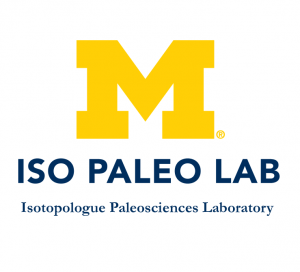 We make the majority of these measurements in IsoPaleoLab, the lab that Naomi co-directs with Ben Passey. They moved from Johns Hopkins in 2016 and the IPL at UM was up and running by early 2018. Here’s the legacy site for the lab at Johns Hopkins to get sense for the earlier iterations of the lab group.
We make the majority of these measurements in IsoPaleoLab, the lab that Naomi co-directs with Ben Passey. They moved from Johns Hopkins in 2016 and the IPL at UM was up and running by early 2018. Here’s the legacy site for the lab at Johns Hopkins to get sense for the earlier iterations of the lab group.
Take a look at the photos on the IPL Instagram account and twitter feed to see the latest lab activity.
Triple oxygen isotopes in the hydrosphere and applications to the geologic record
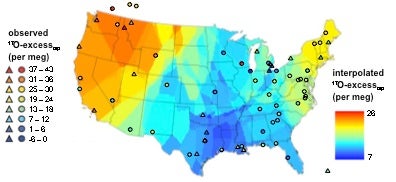 Studying the small variations in the distributions of the three stable isotopes of oxygen (16O, 17O, 18O) has become an emerging field ever since Barkan and Luz (2005) demonstrated that such variations could be measured precisely in waters. Studying triple oxygen isotope distributions in waters, rocks and plants hold promise to provide new tools for understanding Earth’s climate, hydrology and ecosystems.
Studying the small variations in the distributions of the three stable isotopes of oxygen (16O, 17O, 18O) has become an emerging field ever since Barkan and Luz (2005) demonstrated that such variations could be measured precisely in waters. Studying triple oxygen isotope distributions in waters, rocks and plants hold promise to provide new tools for understanding Earth’s climate, hydrology and ecosystems.
If you’re looking for a quick primer on the study of triple oxygen isotopes, or Δ17O, check out postdoc Julia Kelson’s explanations here. Or for a more in-depth look, check out this recent RiMG volume entirely on Δ17O, with a chapter by Passey and Levin (2021) that provides perspective on how it can be used in terrestrial paleoclimate studies. Phoebe Aron’s 2021 Chemical Geology paper provides a review of Triple Oxygen Isotopes in the Water Cycle.
Δ17O in waters and precipitation
Shuning Li, worked in the early days of the JHU lab on Δ17O in waters. She finished her PhD in 2015 and generated the first view of Δ17O variation in North American waters (see Shuning’s 2015 GCA paper). She also generated Δ17O leaf water dataset from Mpala, Kenya (Li et al. 2017, EPSL) which documents Δ17O variation in plant waters and the relationship between Δ17O and d-excess when evaporation is the primary driver of oxygen and hydrogen isotope fractionation in waters. This work has continued with a study of Δ17O in samples from the United States Network for Isotopes in Precipitation (USNIP) in collaboration with Jeff Welker at the University of Alaska Anchorage and from precipitation and river water samples collected by Renée Brooks at the EPA. Preliminary results from this work were presented at the Goldschmidt Conference in Florence, Italy, August 2013 and at the 2014 AGU Fall meeting in San Francisco, CA.
We’re building on this existing to work to expand the geographic range and resolution of sampling to develop a better understanding for how Δ17O in waters tracks with hydrology, climate and geography. Some of this work is piggy-backing on existing research at UM EARTH, like Phoebe Aron and Chris Poulsen’s work on the isotopic composition of precipitation in Peru. Phoebe presented the initial results at AGU 2018 and has a set of papers coming out in 2021 (stay tuned!).
Crowdsource Δ17O project
The water Δ17O work continues to grow. In May 2018, we asked members of the UM EARTH community to collect waters during their summer travels. The response was huge. Over 250 people have collected more than 1600 water samples from 6 continents and 49 countries. UM EARTH postdoc Phoebe Aron (UM PhD, 2020) leads the crowdsource #17Owatermap project. Click here for more information. Many of the crowd sourced work are summarized in Phoebe Aron’s 2021 Chemical Geology paper, Triple Oxygen Isotopes in the Water Cycle.
Δ17O in the geologic record
Our work on Δ17O in waters is in parallel with efforts by Ben Passey and others in IsoPaleoLab to measure and understand Δ17O variation in carbonates.
Lakes: Ben Passey and his former PhD student (JHU), Haoyuan Ji, published the first paper on Δ17O in lake carbonates (Passey & Ji, 2019). Many in IPL are continuing to build on Ben and Haoyuan’s initial study. This includes work by former postdoc Jessica Moerman on the hydroclimate constraints for southern Kenya in the last 500 kyr using Δ17O and initial Δ17O results from the Holocene record from Lake Junin, Peru.
IPL PhD student Sarah Katz is continuing the work in Junín and has developed a detailed view of δ18O, Δ47, and Δ′17O variation in waters and carbonates from the region. Sarah’s work sets up the framework for using these isotope systems to investigate past climate change in the region. Sarah presented these results at AGU 2020 (link to talk on AGU site, link to PDF of abstract).
Tooth enamel: former student Sophie Lehmann (PhD 2016, JHU) reported on Δ17O in teeth to reconstruct paleoaridity at the Annual GSA meeting in 2017 and she’s finalizing a manuscript the reports the results. Stay tuned.
Soil Carbonates: Emily Beverly (former IPL NSF EAR postdoc, now faculty at U. Houston) is working on understanding Δ17O variation in soil carbonates in eastern Africa, figuring out how it works in modern soils from the Serengeti, Tanzania so we can use Δ17O to help constrain our interpretations of δ18O variation in soil carbonates in the geologic record. Emily presented this work at GSA 2020 and the paper is now out in EPSL, Triple oxygen and clumped isotopes in modern soil carbonate along an aridity gradient in the Serengeti, Tanzania. If you don’t have access to EPSL, email Emily or Naomii for it or check out open-access pre-print.
Julia Kelson, NSF EAR postdoc working in both the SCIPP lab and IPL, is examining global Δ17O variation in soil carbonates and finding some distinct patterns. Check out the work she presented at Goldschmidt 2020 here. She also presented Δ17O data on shells and soil carbonates from the Eocene at AGU 2020 – link to talk, PDF of abstract.
Speleothems: Ty Huth, IPL postdoc, has taken on studying Δ17O variation in speleothems, focusing on caves in the western US. Check out his 2020 AGU talk here the describes the basics: link to AGU presentation, link to PDF of abstract. Huth&al2020_AGU
Studies involving triple oxygen isotope variations in waters and carbonates (and anything else we can measure) is a big focus of the group’s current and future research.
Woranso-Mille, Afar Region, Ethiopia
 Woranso-Mille is a Pliocene paleontological site in the Afar region of Ethiopia known for its fossil record of the hominin Australopithecus. I work on this project with a group of paleontologists and geologists with the aim of reconstructing the sedimentological, tectonic and environmental histories in this area. My work specifically involves generating stable isotopic records from fossil teeth and soil carbonates. Some of this work has been published in a PNAS paper that focuses on diets of hominins and monkeys from the early Pliocene. You can find more publications and more about the project here. This work is in collaboration with Yohannes Haile-Selassie, Beverly Saylor, Mulugeta Alene, Al Deino and Luis Gibert Beotas. The project was funded by the National Science Foundation in the past and we’re actively finding ways to fund more work – there’s so much to do!
Woranso-Mille is a Pliocene paleontological site in the Afar region of Ethiopia known for its fossil record of the hominin Australopithecus. I work on this project with a group of paleontologists and geologists with the aim of reconstructing the sedimentological, tectonic and environmental histories in this area. My work specifically involves generating stable isotopic records from fossil teeth and soil carbonates. Some of this work has been published in a PNAS paper that focuses on diets of hominins and monkeys from the early Pliocene. You can find more publications and more about the project here. This work is in collaboration with Yohannes Haile-Selassie, Beverly Saylor, Mulugeta Alene, Al Deino and Luis Gibert Beotas. The project was funded by the National Science Foundation in the past and we’re actively finding ways to fund more work – there’s so much to do!
Naomi presented an overview of the initial results from some of the oldest sediments (3.8 Ma) that we’ve studied at AGU 2020, highlighting the potential for building paleoclimate records from the strata described in the Saylor et al. 2019 paper – check out the talk on the AGU site. Or click here for the abstract alone and here for the video of the recorded talk.
Environmental Change in the Southern Kenya Rift
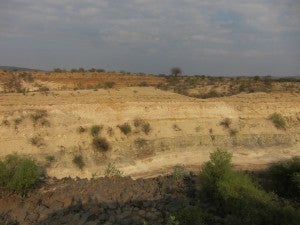 Our work in the southern Kenya Rift involves developing stable isotope records from outcrop and drillcores to reconstruct hydroclimate and ecological change in the region over the last one million years. This work is done as part of efforts led by the Smithsonian Human Origins group. We are currently focusing on outcrop samples from Olorgesailie and drillcore samples from the Olorgesailie Drilling Project (described in this paper by Potts et al. 2020). Among our many collaborators on these projects are Rick Potts and Kay Behrensmeyer, who are both at the Smithsonian National Museum of Natural History. Jessica Moerman’s postdoctoral research focused on on developing triple oxygen isotope and clumped isotope records from both outcrop and core carbonates.
Our work in the southern Kenya Rift involves developing stable isotope records from outcrop and drillcores to reconstruct hydroclimate and ecological change in the region over the last one million years. This work is done as part of efforts led by the Smithsonian Human Origins group. We are currently focusing on outcrop samples from Olorgesailie and drillcore samples from the Olorgesailie Drilling Project (described in this paper by Potts et al. 2020). Among our many collaborators on these projects are Rick Potts and Kay Behrensmeyer, who are both at the Smithsonian National Museum of Natural History. Jessica Moerman’s postdoctoral research focused on on developing triple oxygen isotope and clumped isotope records from both outcrop and core carbonates.
Former IPL grad student Mara Page (MS, 2020) focused her MS thesis on the isotopic composition of teeth from Olorgesailie and observed that grassy diets reigned among the fossil herbivores preserved in the region during the last 1 million years.
Isotopic Composition of Waters from Eastern Africa
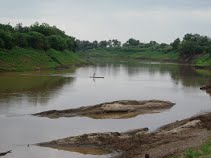 The stable isotopic composition of waters offers an opportunity to use isotopic distributions today as frameworks for interpreting oxygen isotopes archived in the geologic record. Former JHU post-doc Zelalem Bedaso, now at University of Dayton, led an effort to document isotopic variation in precipitation in Ethiopia and deployed daily, weekly and monthly precipitation collectors at 4 weather stations in Ethiopia, in collaboration with the National Meteorological Agency of Ethiopia. The results were published by our team here – Bedaso et al. 2020.
The stable isotopic composition of waters offers an opportunity to use isotopic distributions today as frameworks for interpreting oxygen isotopes archived in the geologic record. Former JHU post-doc Zelalem Bedaso, now at University of Dayton, led an effort to document isotopic variation in precipitation in Ethiopia and deployed daily, weekly and monthly precipitation collectors at 4 weather stations in Ethiopia, in collaboration with the National Meteorological Agency of Ethiopia. The results were published by our team here – Bedaso et al. 2020.
Elandsfontein, Western Cape, South Africa
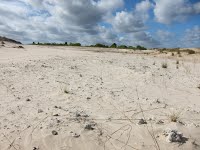 Work at Elandsfontein, a middle Pleistocene paleontological and archaeological site in the Western Cape of South Africa, is in collaboration with David Braun at George Washington University. Our group’s involvement in this project is centered on establishing the stratigraphic and paleoenvironmental context of the fossil and artifact finds at Elandsfontein. Active dune fields that bury the Pleistocene sediments have forced us to make our own outcrop by digging pits and auger holes so that we can actually see the stratigraphy. By taking a look at what’s beneath the modern dunes, we have been able to correlate many of the artifact and fossil localities. See Braun et al. (2013) for a description of the geologic work that we’ve done at Elandsfontein.
Work at Elandsfontein, a middle Pleistocene paleontological and archaeological site in the Western Cape of South Africa, is in collaboration with David Braun at George Washington University. Our group’s involvement in this project is centered on establishing the stratigraphic and paleoenvironmental context of the fossil and artifact finds at Elandsfontein. Active dune fields that bury the Pleistocene sediments have forced us to make our own outcrop by digging pits and auger holes so that we can actually see the stratigraphy. By taking a look at what’s beneath the modern dunes, we have been able to correlate many of the artifact and fossil localities. See Braun et al. (2013) for a description of the geologic work that we’ve done at Elandsfontein.
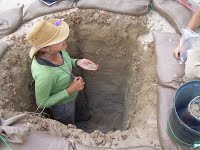 The Elandsfontein work also involves isotopic analysis of materials from Elandsfontein (including fossil teeth) with the goal of building detailed isotopic records of mid-Pleistocene environmental and climatic change for the Western Cape.
The Elandsfontein work also involves isotopic analysis of materials from Elandsfontein (including fossil teeth) with the goal of building detailed isotopic records of mid-Pleistocene environmental and climatic change for the Western Cape.
Sophie Lehmann’s dissertation work (JHU, PhD 2016) focused on the sedimentological and tooth enamel isotopic records at Elandsfontein. See recent papers led by Sophie Lehmann, David Patterson and David Braun with results from our recent work at Elandsfontein. This work was funded by the National Science Foundation.
Gona, Afar Region, Ethiopia
 Gona is best known for archaeological sites that contain the oldest evidence for stone tools in the world, however there is also a rich hominid fossil record that spans the late Miocene through the Pleistocene. In addition to paleoanthropological, archaeological, and paleontological resources, Gona contains an excellent sedimentary archive of >6 million years of environmental change in an active rift basin.
Gona is best known for archaeological sites that contain the oldest evidence for stone tools in the world, however there is also a rich hominid fossil record that spans the late Miocene through the Pleistocene. In addition to paleoanthropological, archaeological, and paleontological resources, Gona contains an excellent sedimentary archive of >6 million years of environmental change in an active rift basin.
I have worked as geologist on the Gona Research Project since 2001. My work at Gona includes stratigraphy, mapping, and isotopic studies of soil carbonates, fossil teeth and mollusks. These studies are part of an initiative to build a complete paleoenvironmental story at Gona, that provides an environmental context for human evolution and an anchor point for characterizing local terrestrial responses to regional climate change in eastern Africa since the late Miocene. My work at Gona is primarily in collaboration with Sileshi Semaw, Scott Simpson, Jay Quade, Gary Stinchomb, Dan Peppe and Stephen Frost, although there are many other scientists who contribute to the research at Gona. All of our work is done with the help of the Afar people.
Turkana Basin, Kenya
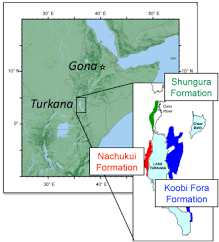 The Turkana Basin, in northern Kenya and southern Ethiopia, contains extensive exposures of Pliocene and Pleistocene sediments (the Omo Group) that fill a depression where the Main Ethiopian and East African rift systems meet. The Turkana Basin is best known for substantial number of hominid fossil remains that have been recovered from the Omo Group deposits, however the ~5,000 km2 of sediment exposures also provide an excellent opportunity to examine environmental variability in a large basin through time. My work in the Turkana Basin primarily focuses on using carbon and oxygen isotope ratios of pedogenic carbonates and fossil teeth to study this variability and link it to regional and global climate change during the Pliocene and Pleistocene. This isotopic work has been in collaboration with Frank Brown, Thure Cerling, John Harris, Meave Leakey, Kay Behrensmeyer, and David Braun.
The Turkana Basin, in northern Kenya and southern Ethiopia, contains extensive exposures of Pliocene and Pleistocene sediments (the Omo Group) that fill a depression where the Main Ethiopian and East African rift systems meet. The Turkana Basin is best known for substantial number of hominid fossil remains that have been recovered from the Omo Group deposits, however the ~5,000 km2 of sediment exposures also provide an excellent opportunity to examine environmental variability in a large basin through time. My work in the Turkana Basin primarily focuses on using carbon and oxygen isotope ratios of pedogenic carbonates and fossil teeth to study this variability and link it to regional and global climate change during the Pliocene and Pleistocene. This isotopic work has been in collaboration with Frank Brown, Thure Cerling, John Harris, Meave Leakey, Kay Behrensmeyer, and David Braun.

